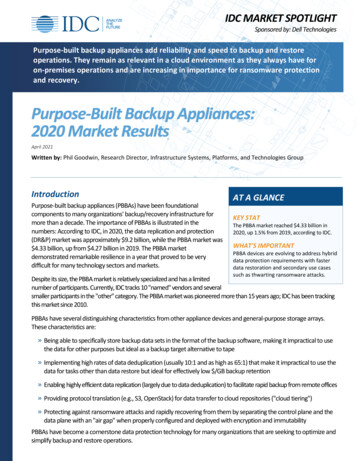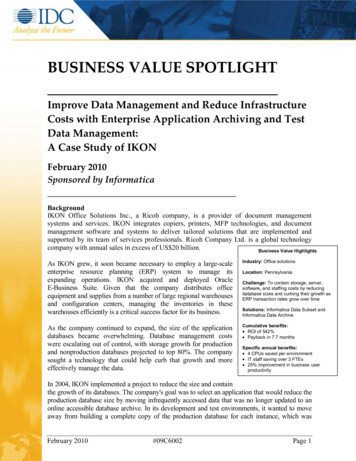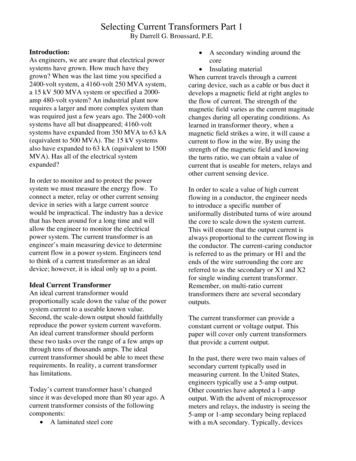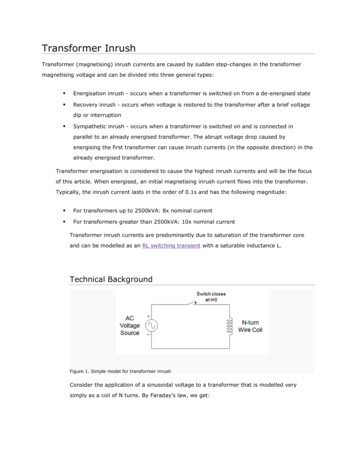
Transcription
IDC MARKET SPOTLIGHTSponsored by: Dell TechnologiesPurpose-built backup appliances add reliability and speed to backup and restoreoperations. They remain as relevant in a cloud environment as they always have foron-premises operations and are increasing in importance for ransomware protectionand recovery.Purpose-Built Backup Appliances:2020 Market ResultsApril 2021Written by: Phil Goodwin, Research Director, Infrastructure Systems, Platforms, and Technologies GroupIntroductionPurpose-built backup appliances (PBBAs) have been foundationalcomponents to many organizations' backup/recovery infrastructure formore than a decade. The importance of PBBAs is illustrated in thenumbers: According to IDC, in 2020, the data replication and protection(DR&P) market was approximately 9.2 billion, while the PBBA market was 4.33 billion, up from 4.27 billion in 2019. The PBBA marketdemonstrated remarkable resilience in a year that proved to be verydifficult for many technology sectors and markets.AT A GLANCEKEY STATThe PBBA market reached 4.33 billion in2020, up 1.5% from 2019, according to IDC.WHAT'S IMPORTANTPBBA devices are evolving to address hybriddata protection requirements with fasterdata restoration and secondary use casessuch as thwarting ransomware attacks.Despite its size, the PBBA market is relatively specialized and has a limitednumber of participants. Currently, IDC tracks 10 "named" vendors and severalsmaller participants in the "other" category. The PBBA market was pioneered more than 15 years ago; IDC has been trackingthis market since 2010.PBBAs have several distinguishing characteristics from other appliance devices and general-purpose storage arrays.These characteristics are:» Being able to specifically store backup data sets in the format of the backup software, making it impractical to usethe data for other purposes but ideal as a backup target alternative to tape» Implementing high rates of data deduplication (usually 10:1 and as high as 65:1) that make it impractical to use thedata for tasks other than data restore but ideal for effectively low /GB backup retention» Enabling highly efficient data replication (largely due to data deduplication) to facilitate rapid backup from remote offices» Providing protocol translation (e.g., S3, OpenStack) for data transfer to cloud repositories ("cloud tiering")» Protecting against ransomware attacks and rapidly recovering from them by separating the control plane and thedata plane with an "air gap" when properly configured and deployed with encryption and immutabilityPBBAs have become a cornerstone data protection technology for many organizations that are seeking to optimize andsimplify backup and restore operations.
IDC MARKET SPOTLIGHTPurpose-Built Backup Appliances: 2020 Market ResultsDefinitionsFor the purposes of this market discussion, IDC identifies the following subsegments of the PBBA market:» Target device: Target PBBAs are disk arrays with specific functionality (i.e., deduplication, encryption) to house andmanage backup data sets. Target devices do not include their own backup software and are intended to work with awide variety of third-party backup applications.» Integrated device: Integrated devices are like target devices in configuration and capability, with the addition ofinstalled and bundled backup software.Despite our attention to these market distinctions for classification purposes, many IT organizations simply view PBBAalternatives based on which system has the desired functionality and convenience of deployment.It is important to distinguish PBBAs from cloud gateway devices. Although both devices may provide protocol translationand transfer of data from on-premises to the cloud, cloud gateway devices are intended to store data for only shortperiods of time (primarily as a data transfer buffer). PBBAs are designed to retain data throughout the life of the databackup and facilitate rapid data restore.BenefitsPBBAs solve several challenges associated with backup. The two primary issues solved are summarized as follows:» Backstopping unreliable tape media and hardware: Tape hardware, highly mechanical in nature, tends to be moreerror prone than disk arrays. Moreover, tape media can be lost, stolen, or broken or have unrecoverable errors.Thus, organizations turn to PBBAs as a primary backup target to reduce backup and restore failures caused bytape-related problems.» Speeding up data restore: As random-access devices, PBBAs can restore individual files very rapidly compared withthe time needed to load, mount, search, and stream a tape. This is especially true if the tape has been moved offsite,where the recall process can be hours or days.» Ransomware protection: Bad actors deploying ransomware have learned to target backup data first so thatsubsequent attacks on primary data cannot be recovered through backup and thereby force ransom payment.PBBAs can be instrumental in defeating these attacks by protecting backup data through layers of "air gap"(i.e., eliminating a physical connection to the backup that hackers can exploit), data encryption, immutable copies ofbackup data that cannot be changed by hackers, and access control methods to prevent in-house attacks.Of course, PBBAs and tape are not mutually exclusive. Many organizations will write one copy of the backup to a PBBAand a second copy to tape, known as disk-to-disk-to-tape (D2D2T). This method offers the advantage of rapid onsite datarestore using the PBBA and the safety of tape offsite storage for disaster recovery (DR) or assured data survival; thisprocess may be done either serially or in parallel. More recently, organizations have begun copying data to the cloud in adisk-to-disk-to-cloud (D2D2C) architecture. This approach offers the same data management benefits as D2D2T but caneliminate the need to handle tapes altogether.#US47582621Page 2
IDC MARKET SPOTLIGHTPurpose-Built Backup Appliances: 2020 Market ResultsWhen selecting a PBBA system, IT buyers must make a choice between a target device and an integrated device. Targetdevices can be used with almost any current backup/recovery software, and as such, they can be added to an existingenvironment seamlessly. Organizations wishing to use their existing backup software will likely choose a target device.Integrated devices have the backup/recovery software pre-installed on the appliance, so the deployment is rapid andsimple. Organizations seeking the simplest implementation will likely choose an integrated appliance. The practicalbenefits of both systems are identical; it is a matter of deployment preference.ConsiderationsThe primary shortcoming of PBBAs is that they really serve only one purpose, which is backup/recovery. Because thedata is highly deduplicated (i.e., data fragments spread across many blocks) and often stored in the proprietary format ofthe backup software, the data stores are not available for additional uses such as analytics. In addition, the time neededto "rehydrate" data (i.e., reassemble it from fragmented blocks into complete blocks) may impact restore times.Fortunately, the industry is responding by adding flash storage and different architectural elements to speed datarestores as well as opening up the data to secondary use cases.TrendsThe total worldwide value of the PBBA market in 2020 was 4.33 billion. Figure 1 shows total market value from 2016through 2020. This value includes target and integrated devices, encompassing both hardware and software includedwith the devices.FIGURE 1: Total Worldwide PBBA Market Size in Revenue, 2016–20204,5004,0003,500( 0Source: IDC's Worldwide Quarterly Purpose-Built Backup Appliance Tracker, March 2021Figure 1 illustrates an overall trend of steady growth for the PBBA market over time. When looking at the target andintegrated market segments separately, we forecast -1.2% growth for target devices and 2.6% growth for integrateddevices in 2021. Currently, target devices constitute approximately two-thirds of the overall market compared withone-third for integrated devices.#US47582621Page 3
IDC MARKET SPOTLIGHTPurpose-Built Backup Appliances: 2020 Market ResultsIn terms of vendor market share, Figure 2 illustrates the share of the top 5 market participants by revenue in 2020.These market share figures are for the total market, including both target and integrated devices.FIGURE 2: Market Share of Top 5 PBBA Vendors Plus Other: Full-Year 2020 ResultsPBBA Vendor Share by Revenue, 2020Dell TechnologiesVendor 2Vendor 3Vendor 4Vendor 5OtherSource: IDC's Worldwide Quarterly Purpose-Built Backup Appliance Tracker, March 2021For the full-year results in 2020, Dell Technologies enjoyed a 47% market share, which includes target and integrateddevices plus associated software. Dell Technologies has been the market leader by revenue for as long as IDC has beentracking the market. Despite the COVID-19 pandemic, the PBBA market showed remarkable resilience in 2020.ConclusionPBBAs provide IT organizations with a solution to common problems associated withbackup/recovery operations as well as improve service-level delivery for data restoreand availability.At 4.33 billion in revenue value, PBBAs represent about one-third of the total spent byIT organizations on backup/recovery hardware and software infrastructure (this doesnot include the amount spent on tape infrastructure, which IDC estimates to be lessthan 1 billion).Although PBBAs were originally designed to solve tape-related problems, they remainrelevant in cloud environments by providing rapid on-premises restore and datareplication to the cloud as well as ransomware protection. Throughout the history of themarket, Dell Technologies, with help from EMC's acquisition of Data Domain, has beenthe market leader. Currently, Dell Technologies has more than twice the market share ofits next nearest competitor in this market.#US47582621PBBAs remainrelevant in cloudenvironments byproviding rapidon-premises restoreand data replicationto the cloud as wellas ransomwareprotection.Page 4
IDC MARKET SPOTLIGHTPurpose-Built Backup Appliances: 2020 Market ResultsAbout the AnalystPhil Goodwin, Research Director, Infrastructure Systems, Platforms, andTechnologies GroupPhil Goodwin is a Research Director within IDC's Enterprise Infrastructure practice, covering research on datamanagement. Mr. Goodwin provides detailed insight and analysis on evolving industry trends, vendorperformance, and the impact of new technology adoption. He is responsible for producing and deliveringtimely, in-depth market research with a specific focus on cloud-based and on-premises data protection,business continuity and disaster recovery, and data availability.MESSAGE FROM THE SPONSORDell EMC Data Protection AppliancesDell Technologies offers a complete portfolio of Purpose-Built Backup Appliances, including both Target, SoftwareDefined and Integrated modelsLearn more at tion/powerprotect-backup-appliances.htmTarget AppliancesDell EMC PowerProtect DD series. The next generation of Data Domain backup appliances delivering enterpriseperformance, efficiency, scale, and cloud support. High performance protection storage appliances in models from4TB to 1.5 PB of usable capacity supporting a variety of access methods and software applications that can be used forboth backup and archive. PowerProtect DD series appliances include cloud tiering for long term retention to public,private and hybrid clouds. PowerProtect DD Virtual Edition provides software defined data protection up to 96TB onpremises and up to 256TB in the public cloud.Integrated AppliancesDell EMC PowerProtect DP series. Simple, powerful cloud enabled integrated data protection appliances for small,mid-size and enterprise organizations. Starting at 8TB, the PowerProtect DP series offers complete backup, replication,recovery, deduplication, instant access, and restore, search and analytics and tight VMware integration — plus, cloudreadiness with disaster recovery and long-term retention to the cloud.#US47582621Page 5
IDC MARKET SPOTLIGHTIDC Research, Inc.140 Kendrick StreetBuilding BNeedham, MA 02494 USAPurpose-Built Backup Appliances: 2020 Market ResultsThis publication was produced by IDC Custom Solutions. The opinion, analysis, and research results presented herein are drawn frommore detailed research and analysis independently conducted and published by IDC, unless specific vendor sponsorship is noted. IDCCustom Solutions makes IDC content available in a wide range of formats for distribution by various companies. A license to distributeIDC content does not imply endorsement of or opinion about the licensee.F 508.935.4015External Publication of IDC Information and Data — Any IDC information that is to be used in advertising, press releases, or promotionalmaterials requires prior written approval from the appropriate IDC Vice President or Country Manager. A draft of the proposeddocument should accompany any such request. IDC reserves the right to deny approval of external usage for any reason.Twitter @IDCCopyright 2021 IDC. Reproduction without written permission is completely forbidden.T US47582621Page 6
Page #US47582621 5 IDC MARKET SPOTLIGHT Purpose-Built Backup Appliances: 20 Market Results About the Analyst timely, in Phil Goodwin, Research Director, Infrastructure Systems, Platforms, and Technologies Group Phil Goodwin is a Research Director within IDC's Enterprise Infrastruc










